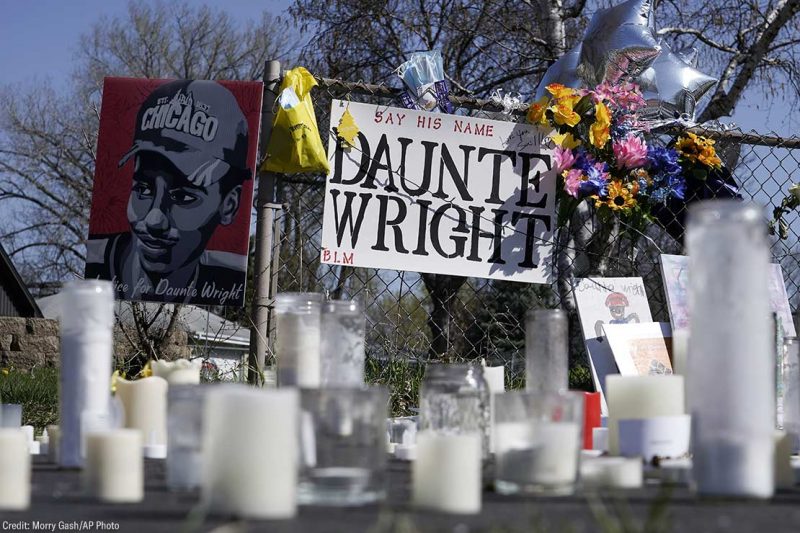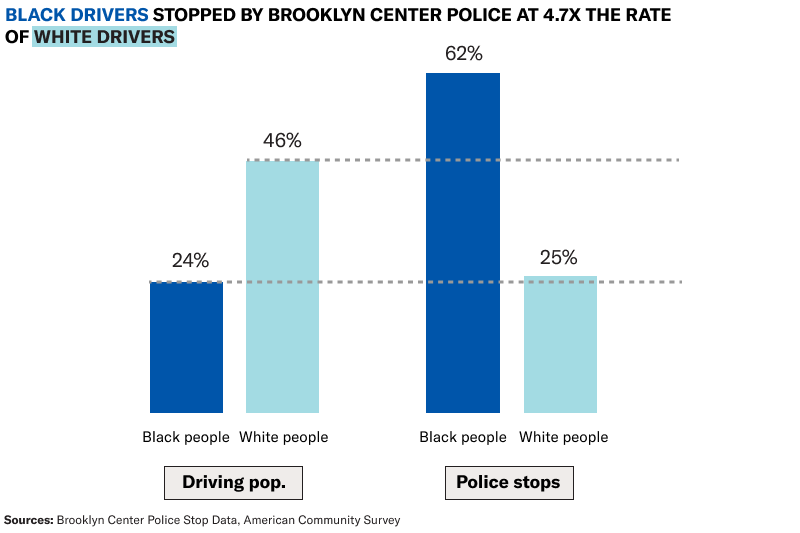Brooklyn Center Provides a Model for Reexamining Public Safety


Daunte Wright and Kobe Dimock-Heisler should still be alive today.
Instead, both of their lives were cut short by Brooklyn Center Police. Daunte Wright was killed at just 20 years old after being pulled over due to expired registration. Wright’s killing joins a long list of Black people whose lives were taken at the hands of law enforcement due to the unnecessary criminalization of minor, petty offenses that are the largest cause of police killings. Eric Garner was killed by an NYPD officer for selling loose cigarettes without a tax stamp, Rekia Boyd and her friends for making noise in a park, and Walter Scott for driving with a broken brake lamp.
Out of the 10.3 million arrests made per year by police, only 5 percent of those are for the most serious crimes (rape, murder, aggravated assault, etc.). The remaining 95 percent are a mixture of offenses that are unnecessarily criminalized and offenses that could have been prevented with investments to address poverty, drug and alcohol addiction, education, and joblessness. This means that police dedicate the majority of their time arresting people for non-serious offenses or those that would not have taken place absent our massive societal overinvestment in police at the expense of all else.
Traffic stops remain the most common way people come into contact with police. Nationally, the annual stop rate for Black drivers was 1.4 times higher as compared to white drivers. The majority of people killed by police in America are killed in response to mental health calls, traffic infractions, and other low-level offenses. Disproportionate rates of police contact, combined with the racial profiling and social control of Black people ingrained in American policing, leads to Black people ultimately being killed by police at 2.4 times the rate of white people.
This weekend, in response to Daunte Wright’s killing, Brooklyn Center Mayor Mike Elliott, who is a former ACLU of Minnesota board member, introduced and Brooklyn Center City Council passed a resolution that can, and should, serve as a model for every city across the country as a way reexamine the meaning of public safety and to invest in alternative public safety mechanisms and structures. This resolution is so critical because we know the only way to truly end police violence is not through minor reforms and tinkering around the edges — it’s by shrinking the footprint of police so they don’t have the chance to kill community members in the first place.

In Brooklyn Center, Black drivers are stopped at more than double the rate of white drivers.
Among other things, the Daunte Wright and Kobe Dimock-Heisler Community Safety and Violence Prevention Resolution will remove police from responses in the community so they don’t have the chance to harm or kill community members by:
- Implementing a citywide “citation and summons” policy requiring officers to issue citations only and prohibit custodial arrests or searches of persons or vehicles for any non-moving traffic infraction, non-felony offense, or non-felony warrant. Such policies would have required, for example, police to simply issue a ticket and walk away from George Floyd, Eric Garner, Mike Brown, and many others killed after police used force and tried to make arrests for low-level offenses;
- Creating a new Community Response Department consisting of trained medical and mental health professionals, social workers, or other expert staff and volunteers, and a dispatch system routing appropriate calls to the Community Response Department and not to the Police Department. Such a program would have meant trained mental health workers would have taken calls related to Kobe Dimock-Heisler instead of armed police;
- Creating a new unarmed civilian Traffic Enforcement Department with the responsibility for enforcing all non-moving traffic violations in the city. Such a program would have meant that a civilian department would have addressed Daunte Wright’s simple expired vehicle registration, instead of being pulled over by armed police officers who killed him; and
- Creating a new permanent Community Safety and Violence Prevention Committee, the majority of whose members must be city residents with direct experience, or the close experience of immediate family members, being arrested, detained, or having other contacts with Brooklyn Center Police.
Every city in America should follow the lead of Brooklyn Center. The best way to prevent the harm caused by police is to fully fund alternatives that end the role of police being the first, last, and only resort in low-income communities and communities of color. Getting police entirely out of these situations is 100 percent effective in avoiding the type of racist and aggressive policing that leads to harm and death. If Brooklyn Center, a town of 30,000, can do this, any locality can and should. No city need wait another day, or for another tragedy, to implement these policies, which will save Black lives.
Police still exist to uphold white supremacy and have been empowered by laws and the courts to inject themselves into Black life for any reason, no matter how minor, even an expired registration. We urge municipalities across the country to implement these types of policies to show that we can save Black lives and foster genuine public safety that doesn’t rely on violence and punishment. The only way to end police violence is to reduce the roles, resources, and power of police — and this resolution does just that.

